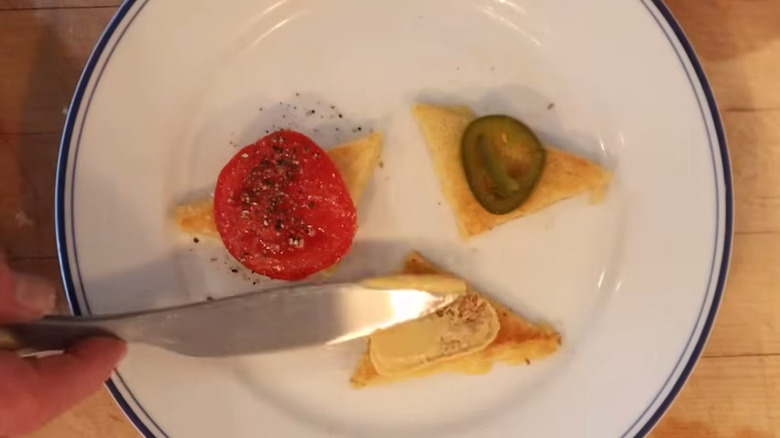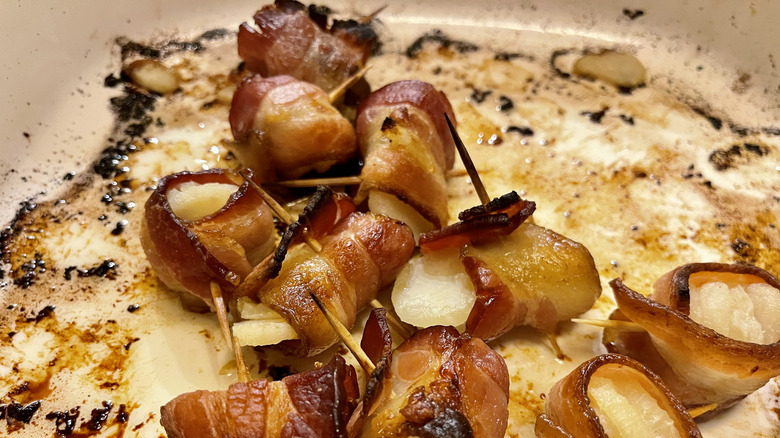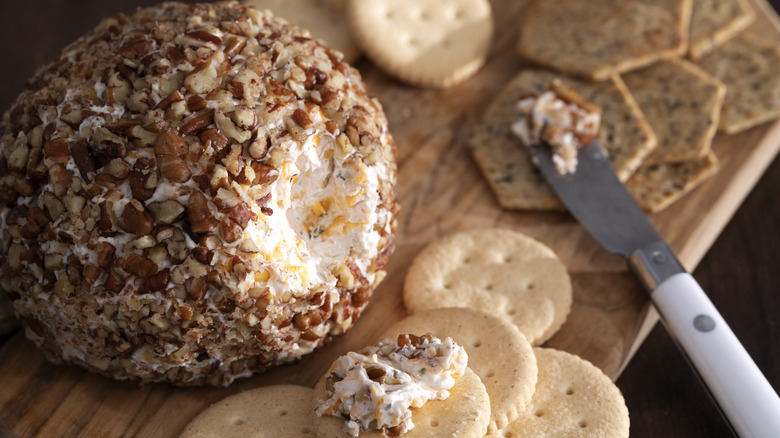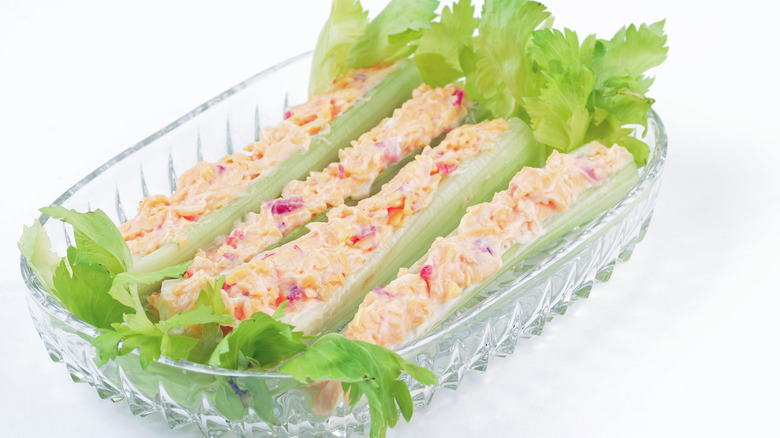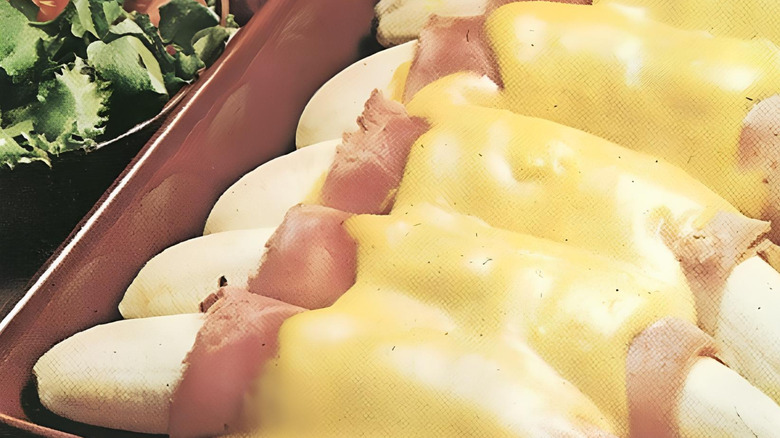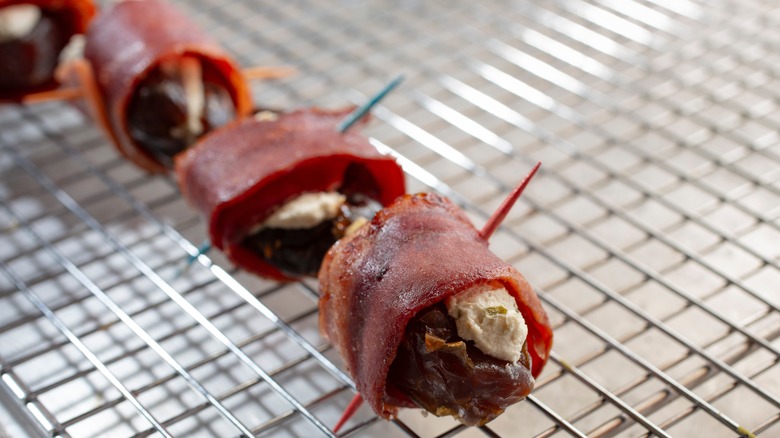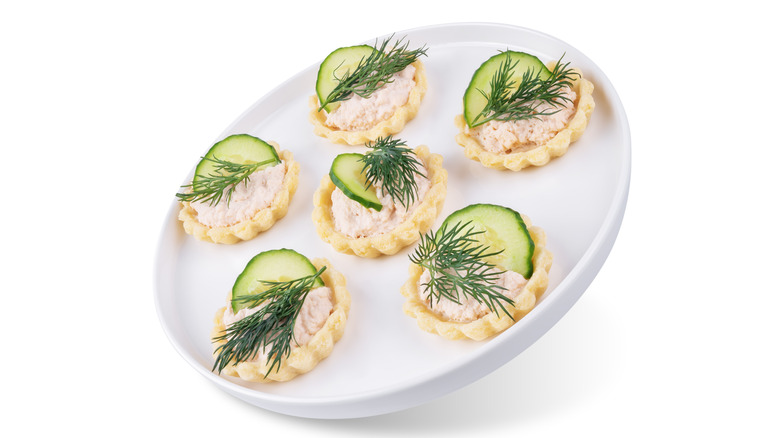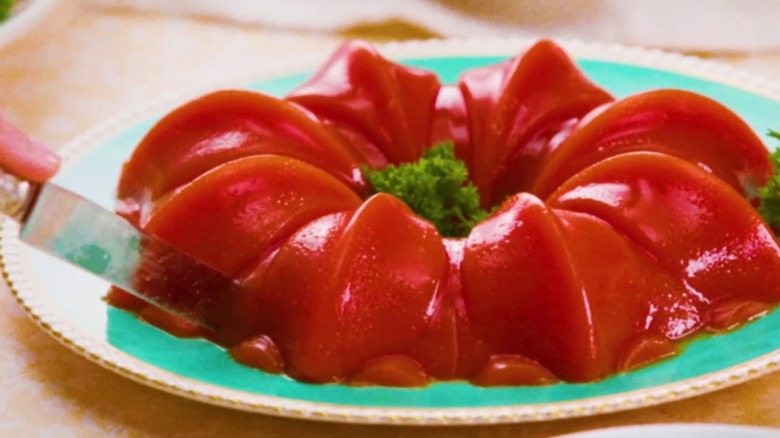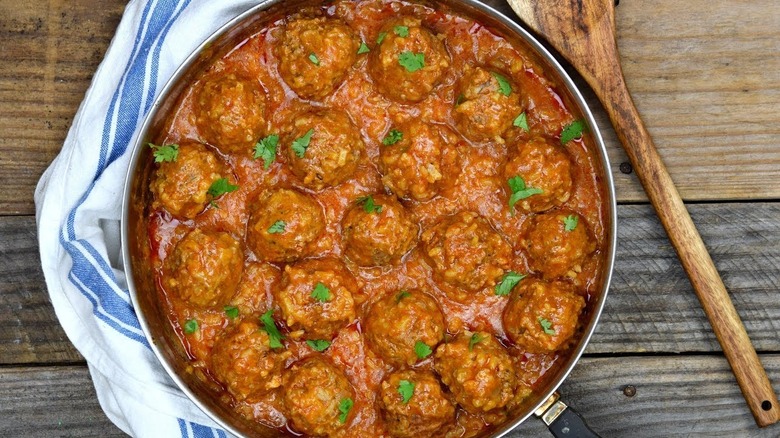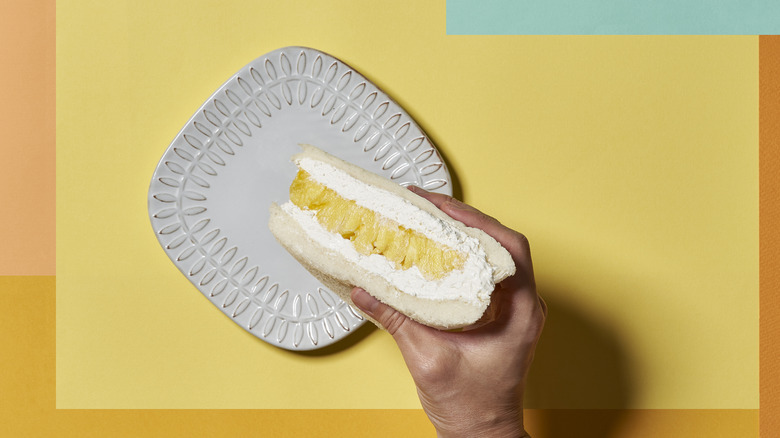11 Old-School Appetizers No One Eats Anymore
Trends change, but few food categories have evolved as noticeably as appetizers. Today's spreads lean into minimalism: one-bite hors d'oeuvres, artisanal dips, and neatly arranged charcuterie boards. But before truffle fries and fig jam became staples, the appetizer course was all about spectacle. Eye-catching, indulgent, and often bizarre.
From the '50s through the '70s, appetizers were designed to impress — and even overwhelm. This was the golden age of finger food, where bold flavors and strange textures took center stage. Picture bacon-wrapped dates, towering cheese balls, ham rolls skewered with toothpicks, and glossy aspic molds dotted with seafood and olives.
Once the stars of cocktail parties, bridal showers, and dinner buffets, many of these retro bites have vanished — edged out by today's focus on health-consciousness and simplicity. Some still appear on holiday menus, however, kept alive by nostalgia. In this deliciously retro roundup, we're revisiting the old-school appetizers that once ruled the party and paved the way for many of the appetizers and delicate canapés we serve today.
Cheese Dream sandwich
Long before grilled cheese became a comfort food icon, there was the Cheese Dream. A buttery, melty marvel that once held star status on American tables. According to Columbia Metropolitan Magazine, its roots trace back to ancient Rome's cheese-and-bread combos, with the first American reference appearing in Marion H. Neil's 1916 cookbook, "Salad, Sandwiches and Chafing Dish Recipes." The sandwich's popularity soared after Good Housekeeping called it "the tried and true tea-house friend," in 1922. Early recipes were typically closed sandwiches. During the Great Depression, The Cheese Dream became popular for being cheap, easy, and comforting-often paired with tomato soup. By the 1930s, the open-faced, broiled version appeared as a way to stretch ingredients, topped with bacon or tomato and praised in a 1932 San Jose News story as "an inexpensive company supper dish." Its popularity endured, and by 1957, Cheese Dreams were advertised as a 55-cent Lenten special in Daytona Beach, Florida's Sunday News Journal.
To bring back this dreamy dish, start with thinly sliced white bread, crusts trimmed. Butter one side generously, add thick-cut cheddar, and fry slowly in hot butter until golden and crisp, with gooey cheese inside. Cheddar was a favorite back then. For a true vintage finish, serve with a spoonful of tomato or mushroom catsup. Want to dress it up? Try slipping in bacon, ham, or tomato before frying.
Rumaki
Rumaki may not be on every modern appetizer menu, but this mid-century favorite once reigned supreme at cocktail parties and tiki bars. Popularized in the '40s and '50s by tiki restaurants like Trader Vic's and Don the Beachcomber, rumaki typically consisted of chicken livers and water chestnuts wrapped in bacon, marinated in a soy-ginger glaze, then broiled to crispy perfection. It was the quintessential hors d'oeuvre of the era: exotic, salty-sweet, and with just the right amount of indulgence, often served on toothpicks and devoured in one bite. Victor Bergeron, founder of Trader Vic's, is credited with bringing rumaki into the spotlight, claiming it descended from Chinese cuisine by way of Hawaii (via Cinnamon Society).
The appetizer became a staple on pu pu platters and gained cultural clout during the baby boomer era, making appearances at suburban gatherings and even on television shows like "Mad Men." However, as tiki culture faded, so did rumaki's prominence. Modern variations exist — some swapping liver for pineapple or scallops — but the original recipe is now mostly reserved for nostalgic cooks and themed events.
To make it, wrap canned water chestnuts in half-slices of bacon, secure with toothpicks, and bake partially to render the fat. Then glaze with a mix of brown sugar, soy sauce, ketchup, maple syrup, Worcestershire sauce, garlic powder, and cayenne. Return to the oven until caramelized and golden. Prefer the classic? Add a chunk of chicken liver to each piece, marinate, and reduce the sauce.
Party cheese ball
Believe it or not, cheese balls date back to 1801, when Elder John Leland from Massachusetts, presented President Thomas Jefferson with the "Mammoth Cheese" — a 1,235-pound wheel crafted from the milk of over 900 cows. Leland rolled it across the White House lawn to present it on New Year's Day, 1802 after a three-week journey. It made headlines and stayed in the White House for years. A similar spectacle occurred in 1835 when Colonel Thomas S. Meacham of Sandy Creek, New York, presented President Andrew Jackson with a 1,400-pound cheddar.
Fast forward to 1944, the modern party cheese ball appeared in Virginia Safford's cookbook "Food of My Friends." Safford, a columnist for the Minneapolis Star Journal, featured a recipe from Mrs. Selmer E. Ellertson, officially introducing the cheese ball as a party dish. This appetizer, typically a mix of cream cheese, cheddar, herbs, spices, and nuts — became the go-to party centerpiece from the 1950s to the 1970s. Especially in the Midwest and cheese-loving states like Wisconsin.
However, its popularity waned in the 1980s, dismissed as kitschy symbols of "middle-class middlebrow" taste in a 2003 New York Times article by food columnist Amanda Hesser. The rise of lighter, fresher appetizers and the growing availability of artisan cheeses shifted party menus away from dense, retro cheese balls designed for sharing. While there has been a minor nostalgic revival, the cheese ball in this form remains mostly a relic of mid-century entertaining, fondly remembered but rarely served today.
Stuffed celery
You might be tossing celery into your favorite green juice today, but did you know this crisp veggie used to be the star of party platters across America? In the early 20th century, stuffed celery became a beloved appetizer, frequently popping up in cookbooks and periodicals of the time. The concept was simple yet elegant: fill celery stalks with creamy mixtures like pimento cheese, cream cheese, or savory spreads, creating a delightful contrast of textures that made them popular finger foods at social gatherings.
Celery itself had long been a fashionable vegetable in American dining. Back in the Victorian era, it was considered a luxury item, often displayed in decorative vases and served raw with cheese, braised, or dressed with mayonnaise. By the early 1900s, it had become a standard part of formal dinners, especially as a light, palate-cleansing dish.
The popularity of stuffed celery peaked mid-century, especially in the 1950s through the 1970s, when simple, easy-to-prepare hors d'oeuvres dominated American party menus. However, as party trends evolved, stuffed celery gradually fell out of favor. According to Food 52, the rise of more complex, exotic, and globally inspired appetizers made the straightforward celery-and-cheese combination seem bland or outdated. Additionally, changing tastes favored dips, spreads, and finger foods with bolder flavors and textures, pushing stuffed celery into obscurity.
Ham banana hollandaise
Ham banana hollandaise stands as one of the most infamous retro appetizers from mid-20th-century America. If you're the kind of person who enjoys diving into quirky forgotten dishes of the past, this one is a fascinating and quite frankly, bizarre retro appetizer. Imagine sweet bananas wrapped in salty ham, slathered with mustard, then baked under a rich hollandaise sauce. While most people know it from McCall's Great American Recipe Card Collection (1973), its roots trace back to a 1947 Chiquita Banana cookbook, where it appeared as "Banana Ham Rolls" with cheese sauce instead of hollandaise (Vintage Recipes). The starter was part of a post-war marketing effort by Chiquita to encourage banana consumption in savory American dishes.
Despite its inclusion in popular recipe collections, Ham Banana Hollandaise was never widely embraced. Rather, it exemplified the era's experimental approach to party food, when home cooks were encouraged to try bold combinations of sweet and savory. The recipe's reliance on convenience products like packaged hollandaise sauce mix and pre-sliced ham also reflects the 1970s' fascination with easy, semi-homemade entertaining. Today, it's mostly remembered as a nostalgic oddity. One that pops up on "regrettable food" lists or resurfaces ironically at retro-themed parties. It's even been roasted on YouTube channels like "Making It Modern" where it is referred to as the most disgusting vintage recipe. Would you ever try it?
Devils on horseback
Devils on horseback have a history as rich as their taste. Picture this: sweet, caramelized dates filled with tangy goat cheese, all wrapped in crispy, smoky bacon. That perfect mix of sweet and savory, creamy and crunchy made these bites a hit at Victorian dinners and mid-century American parties. They originated in 19th-century England. Back then, prunes were sometimes soaked in brandy or tea, then stuffed with almonds or chutney and wrapped in bacon. The dish was served piping hot as a savory course.
The origin of the name? No one really knows. Some say it refers to the heat from mustard, occasionally used in versions like Chillicothe Gazette's 1988 recipe, but this is rare. Others suggest Norman invaders wrapped bacon around their armor to scare enemies, though that's likely just a myth. Believed to be a twist on Angels on Horseback, the dish crossed the Atlantic and became a hit in the U.S. during the 1960s and '70s. Over time, dates replaced prunes, and fillings like goat cheese or blue cheese created a sweet-salty, creamy-crisp combo. They were party staples at weddings, holidays, and festive gatherings.
But like many vintage dishes, devils on horseback slowly slipped out of the spotlight as tastes shifted toward lighter, more international flavors. By the late 20th century, the dish faded from mainstream American appetizer tables. Another contributing factor was the general aversion to prunes and the perceived labor of stuffing and wrapping each piece.
Fish mousse
Before charcuterie boards stole the spotlight, fish mousse ruled the party scene. In the 1960s and '70s, this creamy, savory spread was a staple at American cocktail parties. But it all began in early 1900s France, where tuna mousse, or mousse de thon, combined canned tuna, mayo, and cream cheese, served cold on crackers or toast.
The dish made its way to the U.S. mid-century, where home cooks put their spin on it. They added green onions, Worcestershire sauce, or hot sauce and shaped it into elaborate molds for dramatic flair. This savory showstopper paired perfectly with Ritz crackers and martinis. "The Silver Palate Cookbook" (1979) helped cement its place in entertaining culture with a salmon mousse. Gourmet magazine followed in 1996 with a smoked trout mousse. French chef Pierre Franey also showcased various fish mousse recipes, such as smoked salmon mousse, sole mousse, and salt-cod-and-potato mousse, in his "60-Minute Gourmet" column.
By the 1980s and '90s, however, fish mousse lost ground to lighter, trendier appetizers like hummus and guacamole. Still, for fans of retro recipes, fish mousse is a delicious trip down memory lane — and worth reviving. Want to try it at home? Piatto's Italian Tuna Mousse keeps it simple: blend drained canned tuna, soft butter or cream cheese, a few anchovy fillets, capers, and lemon juice until smooth. Chill and serve with crackers for a nostalgic bite that's sure to spark conversation.
Jellied tomato aspic
Jellied tomato aspic is a savory gelatin mold made with tomato juice, vegetables, and sometimes seafood or meat, and it was once the crown jewel of mid-century American luncheons and holiday spreads. Though aspics have roots in medieval Europe where meat jellies were made by boiling animal bones for collagen, the tomato version didn't take off in the United States until the early 20th century. Thanks to the rise of powdered gelatin, home cooks embraced molded salads for their dramatic flair and convenience.
Stemming from the Greek word aspis, meaning "shield," these jellied dishes were designed to protect their inner salads from the elements, preserving the layers of flavor and texture within their gelatinous glaze. By the 1940s and '50s, tomato aspic recipes often featured canned tomato juice, onions, celery, and a touch of spice—sometimes with olives, shrimp, or even chicken salad tucked into the center. These vibrant, jiggly molds were loved for their eye-catching shapes and ability to stretch pantry staples into party food. They also captured the post-war fascination with convenience foods and culinary showmanship. Aspics like this have almost entirely disappeared due to changing tastes away from gelatin-based dishes and the rise of fresher appetizers.
Porcupine meatballs
Porcupine meatballs are a beloved American comfort food with a fascinating backstory in thrift and ingenuity. Emerging during the Great Depression, this dish was designed to stretch expensive ground beef by mixing it with uncooked rice, onion, and simple seasonings, then simmering the meatballs in a tomato-based sauce. The rice swells and pokes out during cooking, giving the meatballs their signature "porcupine" look and quirky name. The earliest known recipe dates to 1918's Conservation Recipes.
More meatball recipes began appearing in community cookbooks and food columns in the 1930s and became especially common during the 1940s and 1950s. Examples include "Porcupine Meatballs Chinois," which use pork, shrimp, and Asian seasonings, or a 1969 version with cream of mushroom soup and paprika. The dish was often served as a main course but occasionally appeared at potlucks or parties as a hearty appetizer option. Variations included the use of onion soup mix or Worcestershire sauce for extra flavor. Porcupine meatballs fell out of favor after the 1970s as American tastes shifted toward lighter, fresher, and more international dishes. Health concerns also made heavy, processed meals less popular.
Beef tongue canapés
Back in the day, beef tongue canapés were a party favorite. Thin, tender slices of cooked tongue topped crackers or small pieces of bread, and a dab of mustard or horseradish added a sharp kick. They were rich, savory, and surprisingly refined. You'd find them on appetizer trays often alongside other old-school bites. They weren't just elegant; they were economical and flavorful. Originating from traditions brought by Eastern European Jewish immigrants and other cultures that valued nose-to-tail cooking, this savory appetizer was famous for its rich flavor and tender texture after slow cooking, pickling, or smoking.
The popularity of beef tongue canapés peaked in the early to mid-20th century when using all parts of the animal was common and organ meats were less stigmatized. They appeared on buffet tables, cocktail party spreads, and deli menus, often alongside other classic hors d'oeuvres like tongue toast — a similar open-faced sandwich featuring sautéed tongue and eggs.
But as tastes shifted and offal fell out of favor, these rich little bites faded from the spotlight. Still, if you're into retro eats or bold flavors, beef tongue canapés are a delicious nod to a lost culinary era.
Pineapple sandwich
Once a Southern staple, the pineapple sandwich is a curious blend of sweet and savory specialty dating back to the late 19th century, consisting of white bread spread with mayonnaise and stacked with canned pineapple rings. The pineapple sandwich originated in 1898 in Pine Apple, Alabama according to Tailgater Magazine. Its popularity grew in the early 1900s, thanks to Lucille Studley, who successfully canned pineapple in glass jars. This eliminated the need to buy fresh pineapple for quick consumption. At that time, canneries on the West Coast put pineapple in cans, but because of the high cost of shipping, they didn't export east of the Rocky Mountains until they realized Lucille was on to something.
The second ingredient of the PS is mayonnaise, invented in the 1700s by French nobleman Louis François Armand de Vignerot du Plessis, and the third ingredient is specifically white bread. The resulting sweet creamy pineapple sandwich became a Deep South staple at events like school lunch sacks and church picnics. Today, the sandwich's prevalence has declined, especially outside of the Deep South — so much so that many Southerners have never even heard of it.

